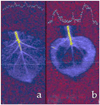Magnetic virus-like nanoparticles in N. benthamiana plants: a new paradigm for environmental and agronomic biotechnological research
- PMID: 21452886
- PMCID: PMC3101318
- DOI: 10.1021/nn200629g
Magnetic virus-like nanoparticles in N. benthamiana plants: a new paradigm for environmental and agronomic biotechnological research
Abstract
This article demonstrates the encapsulation of cubic iron oxide nanoparticles (NPs) by Brome mosaic virus capsid shells and the formation, for the first time, of virus-based nanoparticles (VNPs) with cubic cores. Cubic iron oxide NPs functionalized with phospholipids containing poly(ethylene glycol) tails and terminal carboxyl groups exhibited exceptional relaxivity in magnetic resonance imaging experiments, which opens the way for in vivo MRI studies of systemic virus movement in plants. Preliminary data on cell-to-cell and long-distance transit behavior of cubic iron oxide NPs and VNPs in Nicotiana benthamiana leaves indicate that VNPs have specific transit properties, i.e., penetration into tissue and long-distance transfer through the vasculature in N. benthamiana plants, even at low temperature (6 °C), while NPs devoid of virus protein coats exhibit limited transport by comparison. These particles potentially open new opportunities for high-contrast functional imaging in plants and for the delivery of therapeutic antimicrobial cores into plants.
Figures








References
-
- Douglas T, Young M. Host-Guest Encapsulation of Materials by Assembled Virus Protein Cages. Nature. 1998;393:152–155.
-
- Dragnea B, Chen C, Kwak E-S, Stein B, Kao CC. Gold Nanoparticles as Spectroscopic Enhancers for in Vitro Studies on Single Viruses. J. Am. Chem. Soc. 2003;125:6374–6375. - PubMed
-
- Douglas T, Strable E, Willits D, Aitouchen A, Libera M, Young M. Protein Engineering of a Viral Cage for Constrained Nanomaterials Synthesis. Adv. Mater. 2002;14:415–418.
Publication types
MeSH terms
Substances
Grants and funding
LinkOut - more resources
Full Text Sources

